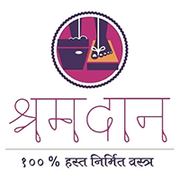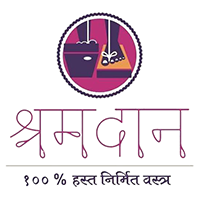There are only a selected few things that are as timeless as a Saree. The history of sarees in Bharat can be recorded way back around 2800 BC in the Indus Valley civilisation.
These sarees were completely handmade, woven using handlooms or hathkargha. These handwoven sarees reflected artisans’ mastered skills, dedication, and sheer love for the art.
Modern sarees, no matter how charming and perfect, fail to reflect human imperfection. The imperfections in handwoven sarees add a unique charm and character that cannot be replicated by machines.
However, hathkargha sarees are experiencing a quiet but powerful revival. No longer confined to heirlooms or special occasions, these handcrafted weaves are returning to everyday wardrobes, contemporary styles, and even global runways. Their resurgence is not just about nostalgia, it's about sustainability, identity, and reclaiming slow fashion in a fast-paced world.
What Are Hathkargha Sarees?
The term hathkargha simply means “handloom” in Hindi. It refers to the traditional manual loom operated without electricity. Each saree woven on a hathkargha is a unique piece of slow-crafted textile which can take days or even weeks to complete.
What makes hathkargha sarees special is the meticulous attention to detail, the use of natural fibers like cotton, and the deeply cultural motifs that reflect regional culture and way of living. Bharat, with its diverse textile traditions, boasts over 135 unique weaving clusters including the intricate Jamdanis of Bengal and luminous Kanjeevarams of Tamil Nadu, to the earthy Maheshwaris of Madhya Pradesh and bold Sambalpuri patterns of Odisha.
Just a simple look at the saree design is enough to decipher its origin.
The Dark Period of Handloom Sarees

After surviving more than 4000 years and being worn during the Vedic, Mauryan, and the great Maratha period, the hathkargha sarees witnessed steep decline during the industrial revolution. Cheaper and more accurately stitched modern sarees took over which left millions of artisans without any source of income. Let’s have a look at some of the reasons in brief:
-
Industrialization and the rise of power looms: The primary reason that led to the ultimate downfall of hathkargha sarees was the Industrial revolution. Machines mass produced sarees at much affordable prices, flooding markets and reducing demand for handcrafted weaves.
-
Urban migration and lack of interest among youth: Less sales of handloom sarees led to younger artisans moving away from weaving to opportunities that guaranteed much stable sources of income. These led to the further decline in sales of traditional sarees.
- Changing consumer behavior: As fast fashion become mainstream and affordable, buyers gravitated towards trend-based, ready-to-wear outfits over handcrafted sarees.
-
Lack of awareness: Many didn’t know how to identify real handloom sarees or appreciate the skill and effort behind them.
-
Cost: Handloom saree prices were also higher in comparison to machine made sarees which didn’t help a country that was recovering financially after the British rule.
The result? Weaving communities struggled, traditions faded, and valuable cultural knowledge was at risk of being lost.
The Inevitable Comeback of Hathkargha Sarees
Traditional handloom sarees are making a strong comeback. Here are some of the factors responsible for this revival:
Sustainability and Slow Fashion Movement
One of the primary factors that has led to the revival of handloom sarees and clothing in general is the global shift towards sustainability. As more people get aware of the negative effects of fast-fashion, they are actively exploring sustainable options for better tomorrow.
The best hathkargha sarees are naturally sustainable:
- They’re woven using little or no electricity
- Made with biodegradable fabrics like cotton
- Produced in small batches with minimal waste
For mindful consumers, they offer both ethics and elegance.
Cultural Reconnection and Pride
There’s also a growing movement, especially among young Bharatiyas, to reconnect with their roots. Wearing a handloom saree is now seen as a form of art, cultural expression and a way to honour tradition while creating new meanings.
Be it festive wear, office attire, or even weddings, hathkargha sarees are being embraced with pride as a piece of cloth with emotions and deeper meaning.
Design Innovation and Modern Styling
Along with the shift in perspective from the consumers, artisans have also tried to upgrade themselves according to modern styles. Today’s hathkargha sarees are:
- Lighter and easier to drape
- Styled with minimalist borders or contemporary colours
- Paired with crop tops, belts, or sneakers for fusion appeal
This fresh design language has made handloom more accessible to the younger generation.
Digital Platforms and E-Commerce
Technology has played a huge role in the revival. From Instagram storytelling to dedicated e-commerce platforms, weavers can now reach buyers directly.
Shoppers, too, enjoy transparency: they can read the weaver’s story, understand the weaving process, and buy with trust.
Impact on Weaving Communities
The revival of hathkargha sarees has led to real, on-ground change. In many weaving clusters:
- Artisans who once abandoned their looms are returning to the craft
- Women weavers who make up to 70% of total weaves are gaining financial independence
- Generational skills that were once on brink of extinction are being passed on like a treasured skill.
This resurgence is not just about fashion, it’s about preserving a livelihood, a heritage, and a way of life.
Challenges That Still Remain
While the momentum is promising, several hurdles that still exist:
- Power loom replicas: Machine-made copies of handloom sarees often confuse buyers and hurt authentic weavers.
- Inconsistent income: Many artisans still face irregular work and low pay, especially in off-seasons.
-
Lack of consumer awareness: Not everyone knows how to recognize or differentiate genuine handloom sarees.
The road to revival is ongoing and it needs continued awareness, support, and policy-level action.
What You Can Do to Support the Revival?
Even small steps can make a big difference. As a consumer, you can:
- Buy directly from weavers, craft fairs, or verified handloom platforms
- Gift handloom sarees during weddings, festivals, or milestones
- Educate others about the value and craft of hathkargha sarees
- Celebrate regional weaves in everyday wear and social occasions and actually post it on social media platforms.
Your choices help sustain centuries-old knowledge and create dignified livelihoods.
Hathkargha Sarees by Shramdaan
Shramdaan has played an integral role in this revival phase of hathkargha sarees. Our charitable trust has provided employment opportunities to numerous artisans from rural Bharat who know the art of making handloom sarees. Our collection includes khadi sarees, printed sarees, ikat sarees and kundalpuri sarees. Here are some of our best handloom sarees online:
1. Fire Yellow Saree with Zari and Red Border and Butis

Fire Yellow Saree with Zari and Red Border and Butis (Kundalpuri Saree)
2. Hand Embroided Zardozi Saree

Hand Embroided Zardozi Saree (Hand Embroidered Sarees)
3. Multi Ikat Saree with Golden Zari Stripped and Golden Zari Border

Multi Ikat Saree with Golden Zari Stripped and Golden Zari Border (Ikat Saree)
4. Self Striped Off White Saree with Dark Red Border

Self Striped Off White Saree with Dark Red Border (Khadi Saree)
5. Handwoven Naturally Dyed Indigo Saree

Handwoven Naturally Dyed Indigo Saree (Printed Saree)
Conclusion
The hathkargha saree is more than a garment. It’s a piece of Bharat’s cultural heartbeat that was spun with heritage, dyed in memory, and woven with love. Its revival in the 21st century isn’t just about going back to the past. It’s about moving forward with more intention, more pride, and more care.
Support our charitable trust and Bharat’s skilled artisan by purchasing our clothing and accessories from our platform or our physical outlets. Along with sarees, we also sell 100% sustainable shirts, kurtas, towels, yoga mats, gamcha, dhoti and more. Shop Now.





